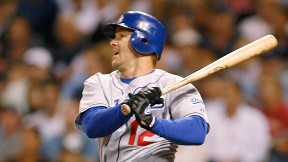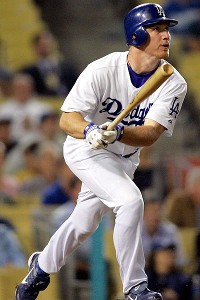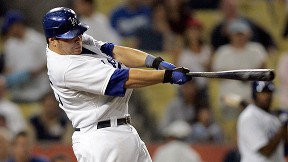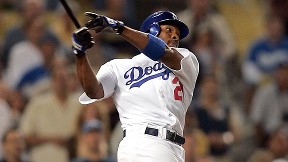For more images from today, visit the Dodgers Photog Blog.
By Jon Weisman
Let’s recap the first Saturday of Spring Training …

For more images from today, visit the Dodgers Photog Blog.
By Jon Weisman
Let’s recap the first Saturday of Spring Training …
By Jon Weisman
Now that all the hoopla of Saturday’s FanFest has given way to rain, wind and an element to be named later, let’s check in on the latest with a few of your intrepid Dodger heroes.
Yasiel Puig
About three feet in front of me Saturday, near the FanFest stage, Dave Roberts and Yasiel Puig shared an enthusiastic hello and embrace. When I tweeted this, I was met with some skepticism, but the relationship ball is rolling, according to Ken Gurnick of MLB.com.
“I just had a good sit-down with him,” Roberts said. “It was refreshing for me to have a good face-to-face with him, to talk about our vision, and it’s more of, ‘Let’s wipe the slate clean’ and everything’s new. There’s the same core of players but a completely new coaching staff, and we just want him to be himself and let’s start fresh.”
By Jon Weisman
It’s no exaggeration to say that Jackie Robinson is the pride of Muir High School, just as he is the pride of the Dodgers and, for that matter, the United States.
So it was a special day for everyone today when this week’s Dodgers Love L.A. community tour (presented by Bank of America) made a stop at Muir, with a screening of portions of Ken Burns’ upcoming “Jackie Robinson” documentary, followed by a Q&A featuring manager Dave Roberts and team historian Mark Langill, moderated by broadcaster Jorge Jarrin.
Many of the four score students in attendance today will graduate from Muir exactly 80 years after Robinson did. But not to worry — his story still resonates.
“I loved the documentary,” said Bryan Barrios, senior captain of the Muir baseball team. “It was very inspiring (and) emotional. I walk around this campus just thinking about Jackie Robinson all the time. Sometimes I can’t believe he came here.”

Pitching coach Rick Honeycutt visits Carlos Frias at the mound during a May 24 game. (Jill Weisleder/Los Angeles Dodgers)
By Jon Weisman
As a rookie manager who neither pitched nor caught in his big-league career, Dave Roberts will be scrutinized for every move he makes with the Dodger pitching staff. (I know — I could have just begun, “As a manager.”)
Today, Roberts spoke about his approach will be, and how he will use pitching coach Rick Honeycutt and bench coach Bob Geren as resources.

Image via Parks Moving, Pittsburgh, Pennsylvania
By Jon Weisman
Not only are there new names in the Dodger coaching staff, there’s a new title — one that might seem kind of out there.
But “quality assurance coach,” the role to be filled by former Dodger infielder and minor-league infield coordinator Juan Castro, is actually a very down-to-earth role, according to Dodger manager Dave Roberts.
By Jon Weisman
Dallas is a pretty convenient stop on the way from Los Angeles to Nashville, and Clayton Kershaw’s house is a pretty nice place for a layover.
So on his way to baseball’s annual Winter Meetings, new Dodger manager Dave Roberts spent several hours meeting with Kershaw, to discuss next year’s team in general and the departure of Zack Greinke in particular.
[mlbvideo id=”532636883″ width=”550″ height=”308″ /]
Fresh off the Think Blue Review presses, this week’s edition captures Dave Roberts introduction today as Dodger manager.
Jon SooHoo has also posted a photo gallery from this warm welcome.
– Jon Weisman
Hey, Skip! pic.twitter.com/qNyR3l8vgB
— Los Angeles Dodgers (@Dodgers) December 1, 2015
By Jon Weisman
Dave Roberts is being introduced at Dodger Stadium shortly after 11 a.m. as the Dodgers’ manager. We’ll highlight some of the key quotes as they come here …
(Also, note that Roberts will be holding a live Q&A on Twitter this afternoon – check the hashtag #AskDave.)
Introducing Roberts is Dodger president of baseball operations Andrew Friedman: “We are highly confident that he is going to play a significant role in us shaping a culture of sustained success here. Magic Johnson then presents Roberts with his Dodger jersey, wearing No. 30.
Roberts begins with some introductory remarks:
https://twitter.com/Dodgers/status/671771309529939968/photo/1
Next, the Q&A begins:
By Jon Weisman
Welcome to Dave Roberts’ honeymoon with Dodger fans and the media.
The new Dodger manager hasn’t been asked a question, hasn’t made a move. His rose is in full bloom.
But it takes two to be happy in a marriage, and let’s just say that Roberts’ collective new spouse — after 27 years of frustration — can be a bit challenging to keep satisfied.
Dodger director of graphic design Ross Yoshida passed along this video of Dave Roberts when he was the prankee on a September 2003 episode of “The Jamie Kennedy Experiment” on the ol’ WB Network. (Former Dodger catcher Paul Lo Duca is in on the bit.) The Dodgers’ new manager is patient — really patient — but firm and in the end, able to take a joke.
— Jon Weisman
By Jon Weisman
Dave Roberts made his Los Angeles debut with the 2002 Dodgers, a mostly forgotten squad whom a couple of weeks ago I called the best third-place team in Dodger history.
Those Dodgers won 92 games but finished behind Arizona and San Francisco in the National League West. Under the current playoff format, they would have made the NL wild-card game against the Giants, who ended up in the World Series against the Angels.
Instead, the ’02 Dodgers missed the postseason entirely, so their record as a team has largely been ignored. But in addition to the arrival of Roberts, there were these individual memories:
By Jon Weisman
Dave Roberts first came to the Dodgers as a nobody. On December 22, 2001, the Dodgers traded two single-A minor-leaguers, Christian Bridenbaugh and Nial Hughes, to Cleveland for an outfielder who had 40 career Major League hits at age 29.
Neither Bridenbaugh nor Hughes would play at any level in any of MLB’s 30 organizations again. But Roberts, he wouldn’t easily be forgotten.

Dave Roberts had a .342 OPS in 1,189 plate appearances with the Dodgers from 2002-04 and ranks 20th in franchise history with 118 stolen bases. (Juan Ocampo/Los Angeles Dodgers)
By Jon Weisman
Dave Roberts, named interim manager of the San Diego Padres today after Bud Black was fired, is the latest in a line of Padre managers with Dodger ties.
Black, who replaced Bruce Bochy, had managed the Padres since 2007.

For the five years since it took place, I’ve had this vision of the 4+1 game.
September 18, 2006. I replay the game in my head, a game that, unfathomably, stood toe-to-toe with the R.J. Reynolds game in 1983 as the greatest game in Dodger Stadium history, and I hear The Who’s “Had Enough” as the soundtrack.
As the 2006 baseball season bore down on its finish, the Dodgers were in a vexing battle with the San Diego Padres for first place in the National League West. An 11-5 pasting by the Padres knocked Los Angeles into last place on May 5. The Dodgers staggered back and reached first barely a month later, but in a tight division, San Diego drove them back to last with a 7-6, 11-inning victory July 24.
It was that kind of year. When the first day of August dawned, the Dodgers were still on the bottom looking up. Just 10 days later, Kenny Lofton’s walkoff RBI single beat Colorado, and the Dodgers were atop the NL West looking down.
And there in first place they stayed, until September 17, when Padres pinch-hitter Termel Sledge’s RBI single in the ninth inning broke a 1-1 tie, leading to Jonathan Broxton’s first career loss in the majors. The Dodgers had handed first place back to San Diego again.
And so when I think of September 18, 2006, I hear Roger Daltrey singing, practically shouting …
I’ve had enough of bein’ nice
I’ve had enough of right and wrong
I’ve had enough of tryin’ to love my brother …
* * *
It was an unusual night – a Monday finale of a four-game series. “Here we go ahead for the final time,” Vin Scully said at the start of the local cable broadcast, “the Dodgers desperate for a win. … If it feels like a playoff or postseason game, that of course is the aim of each team.”
Three players who had begun Sunday’s game on the bench were in the Monday starting lineups. The fellow batting cleanup for San Diego was familiar – his name was Mike Piazza, slugging .500 in his first season in San Diego after 7 1/2 in New York and in his final season in the National League.
For the Dodgers, the two big changes were these: Rookie outfielder Andre Ethier was rested in favor of new acquisition Marlon Anderson, and returning to play after missing two games with a strained quad was Nomar Garciaparra, who had talked manager Grady Little into starting him. At the time, you had to know their numbers or their looks to know who these guys were – this was part of the brief era in which the Dodgers wore no names on the back of their jerseys.
On the mound, who knew what to expect? Brad Penny had earned a start in that summer’s All-Star game, striking out Ichiro Suzuki, Derek Jeter and David Ortiz in the first inning, but had been inconsistent ever since, posting a 5.81 ERA. In his past two starts, he had lost 7-0 to the Mets and won 6-0 against the Cubs. On the other side, Jake Peavy had been dominating the Dodgers as usual (two runs allowed in 14 previous innings that year), but his overall season ERA was a modest 4.17.

With fans still pouring in to the ballpark, Penny retired the first two hitters, Dave Roberts and Brian Giles, before Adrian Gonzalez lined a 3-1 pitch into center field, bringing Piazza to bat.
“In recent games against the Dodgers, Mike looked like he was pressing,” Scully said as Piazza worked the count full. “He was trying to pull pitches that were down and away.” Almost on cue, we saw vintage Piazza, hammering the 3-2 pitch, driving it five feet below the top of the center-field wall on the fly, for an RBI double. The game was on: 1-0 Padres.
Penny walked Russell Branyan, bringing a visit to the mound from Rick Honeycutt and a visit to the plate from Mike Cameron, whom Scully pointed out had hit five home runs against the Dodgers so far in 2006. On the first pitch after Honeycutt returned to the dugout, Cameron shot the ball off the short wall in right field for a standup triple, driving in two runs (Nos. 14 and 15 vs. Los Angeles that year) to make the score 3-0.
“The Dodgers in a huge hole,” Scully said. Down in the Dodger bullpen, Aaron Sele began to warm up – not for the first time this night. Not by a longshot.
Nor was the hole finished being dug. Geoff Blum hit an 0-2 pitch to right field to drive in Cameron for a 4-0 lead, before Josh Barfield flied out to finally end the inning.
But the Dodgers wasted no time trying to rally. Rafael Furcal bunted for a single, and Lofton’s hit sent him to second. Garciaparra hit into a 6-4-3 double play, but ever-irascible Jeff Kent doubled to deep center field, driving home Furcal to get Los Angeles on the scoreboard. Peavy limited the damage to one run, but as he walked off the mound, he and Dodger first-base coach Mariano Duncan began shouting at each other.
I’ve had enough of bein’ good
And doin’ everything like I’m told I should
If you need a lover, you’d better find another …
* * *
The Dodgers pulled closer. After Penny struck out three in the second inning, Anderson – the August 31 discard from the Washington Nationals who had made surprising contributions in Los Angeles – hit a one-out solo home run. And after Russell Martin threw out Cameron trying to steal to end a two-out Padre threat in the top of the third, Furcal hit a solo homer of his own to dead center field.
“A mighty man is he,” Scully said of Furcal, who hit 15 home runs that year. “And you want to talk about a team trying to bounce back.”

Before the inning was over, Kent hit his second double in as many at-bats, once more to center field, a ball at the wall that Cameron leaped for but came up empty. “Standing hands on hips, trying to figure out how he missed it,” Scully observed.
J.D. Drew entered the box next, and he sliced a breaking ball left up in the zone by Peavy for a ground-rule double to left field to tie the game, bringing the crowd to its feet. In fact, Martin then almost put the Dodgers ahead right there, but Peavy speared the first-pitch line drive off his bat.
The score was 4-4 after three innings. Not once over the next four innings was a team retired in order, but not once did a team score.
Each missed a tremendous opportunity. In the top of the fifth, after another Gonzalez single, Penny walked Piazza and Branyan to load the bases with two out, but Cameron flied to right. In the bottom of the sixth, Anderson singled, Wilson Betemit walked and pinch-hitter Oscar Robles loaded the sacks with none out when he sacrificed and reached first on a fielder’s choice. But Furcal hit into a forceout at home, and then Lofton grounded into a 1-2-3 double play.
By the eighth inning, the starting pitchers were long gone. And so was any remnant of sanity in this game. The attendance was announced. Five years ago tonight, the Dodgers drew a legitimate 55,831 fans. Five years ago tonight, the Dodgers registered their highest ticket sales for a Monday game ever, capping a record for a four-game series: 219,124.
Broxton entered the game in the eighth inning. Scully commented that after Sunday’s loss, Broxton had said wasn’t nervous, but he was worried he had been tipping his pitches. “Jon was just 22 in the middle of June when he made the jump from Jacksonville, and now he has the key role as the set-up man.” It was his fifth game in seven days; he had thrown 88 pitches since the previous Tuesday, and was about to throw 22 more.
Things soon turned grim. With one out, Blum walked, and Barfield drove one to right-center field that Drew couldn’t get. Lofton overran the carom, Martin dropped the throw home, the go-ahead run scored and Barfield ended up on third base. Pinch-hitter Todd Walker then hit a flare over the drawn-in infield to give San Diego a two-run lead.
Roberts struck out (a career-high fourth for the former Dodger outfielder), but Walker went to second on a steal and third on a wild pitch. Giles then sent Drew to the right-field wall, which he banged into while making the inning-ending catch.
Not once had the Dodgers led, but not once had they failed to score in an inning in which they trailed. Sure enough, off reliever Scott Linebrink, Anderson drove one down the right-field line, running through a stop sign to reach third base with a triple, and Betemit lined an 0-2 pitch up the middle. Just like that, the lead had been reduced to one.
“Boy is this a game, huh?” Scully marveled. “Wow. And this crowd loving every moment of it. It’s been a roller-coaster ride from depression to euphoria and all the stops in between.
“Boy, it’s not Monday night here. It is Mardi Gras night. It is New Year’s Eve night.”
With two out, Lofton doubled with two out to send pinch-runner Julio Lugo to third base. Tying run was 90 feet away, go-ahead run one base behind him.
But Garciaparra struck out. You could practically fit the goat’s horns for him.
Life is for the living
Takers never giving …
* * *
Takashi Saito, the 36-year-old first-year major-leaguer from Japan, was asked by the Dodgers to protect the one-run deficit. There was little reason to expect he wouldn’t: In 70 innings, emerging in the spring in the wake of Eric Gagne’s last gasp as a Dodger, Saito had a 1.93 ERA and 93 strikeouts against 63 baserunners in 70 innings.
The importance of keeping the Padres close was clear, as Scully noted. “They’ve won 26 games by one run,” he said, “and one of the big reasons is warming up in the bullpen. Yep, it’s Trevor time.”
But Gonzalez led off the ninth with his third single of the game, and Manny Alexander (Piazza had exited the game for a pinch-runner in the seventh) bunted him to scoring position. Up came Josh Bard, the Padres’ lesser-known catcher but one who had an .869 OPS, even better than Piazza at that moment.
On a night filled with long fly balls, Bard drove what appeared to be the capper of the night, to deep center. Lofton went back. He leaped. His glove went over the fence; the ball banged off his wrist and back onto the field, while an uncertain Gonzalez advanced only to third. “Goaltending,” remarked Scully as he watched the replay.
Saito walked Cameron intentionally in the hopes of forcing an inning-ending double play, but his next pitch to Blum went to the backstop, and the Padres doubled their lead. Then Blum hit a sacrifice fly, and San Diego led by three in the ninth. Scully practically threw the white flag.
“And the Dodgers will have to collect themselves and go after Pittsburgh,” he said. “It has been a Friday night and a Saturday night combined emotionally, but now it’s starting to feel like Monday.”
It’s not as if the Padres got greedy after that, but you could argue they suffered from an embarrassment of riches. After Barfield singled to drive in Cameron and give San Diego a 9-5 lead, Scully glanced back at the Padres bullpen, looking to see if Trevor Hoffman was still getting loose.
“We said it was Trevor time, but maybe not,” Scully reported. “Nope, it’s Jon Adkins now. That figured.”
Jack Cust made the third out of the top of the ninth. The Dodgers trailed by four runs in the bottom of the ninth.
Up to that point, Adkins had allowed one home run in 51 1/3 innings in 2006.
“The Dodgers are asked to do what they did (before), but they’ve run out of innings,” waxed Scully.
Here comes the end
Here comes the end of the world …
* * *

And then, a symphony …
Kent conducts a 1-0 pitch to center field, over Cameron, and out of the park.
“So Adkins is rudely treated,” Scully says. “Two pitches, one run.”
Drew, strumming the strings on a 2-1 pitch …
“And another drive to deep right center, and that is gone! Whoa, was that hit!” exults Scully.
“What is that line? Do not go gentle into that good night. The Dodgers have decided they’re not going to go into that night without howling and kicking.”
Hoffman is quickly rushed into the game. “He has been absolutely magnificent against everybody, but especially against the Dodgers,” Scully says, adding that Hoffman’s last blown save against the Dodgers was in April 2001.

Hofman throws his first pitch.
“And a drive to left center by Martin,” calls Scully. “That ball is carrying into the seats! Three straight home runs!”
Bedlam at Dodger Stadium, bedlam like it’s the ninth inning on September 11, 1983. But the Dodgers, as Scully reminds us, “are still a buck short.”

Anderson is the next batter. He has four hits and needs a double to hit for the cycle.
Hoffman throws his second pitch. Anderson swings. Immediately after his follow-through, he jolts out of the box …
“And another drive to right center …”
… two arms thrusting in the air …
“Believe it or not, four consecutive home runs! And the Dodgers have tied it up again!”
As Martin practically had to be restrained in the dugout from running onto the field, Anderson raced around the bases, leaping into his high five at home plate before sprinting to the dugout, where he disappeared under a white and blue volcano.
It was the first time since 1964 that a team had hit four consecutive home runs, and the first time it had ever been done in the ninth inning, let alone to erase a four-run deficit. (The six homers in nine innings were also the most by the Dodgers since they hit eight in the Shawn Green game in May 2002.)
“Can you believe this inning?” exclaimed Scully, still agog. “Can you believe this game? … It is an unbelievable game.”
Before the cheering had even begun to subside, Lugo swung at his first pitch – still only the third pitch Hoffman had thrown in the game – and hit it on a trajectory to right-center that, for an instant, made the fans double-take. But it landed in Cameron’s glove. Ethier, batting for Saito, blooped out.
In the Dodgers’ last chance to win in nine innings, Furcal, 2 for 5 with a home run already, tattooed one himself, taking Giles to the warning track to right field before it was caught.
“Well, wouldn’t you know this was gonna go extra innings?” Scully said. “No, I don’t think you did when it was 9-5 in the ninth.
“This crowd is beside itself with joy. You can come down the wall now.”
* * *
With their top relievers already used, the Dodgers turned the guy that had warmed up for the first time back in the first inning, Aaron Sele. One of general manager Ned Colletti’s ongoing reclamation projects on the mound, Sele had joined the Dodger starting rotation in May and had a 2.91 ERA in 65 innings before the All-Star break. After a couple of poor July starts, soon followed by the acquisition of Greg Maddux, Sele ended up spending most of his second half in the bullpen (the Dodgers’ No. 5 starter that September, you might be surprised to remember, was Hong-Chih Kuo). Sele’s ERA had risen to 4.35, and he had pitched three total innings in the past two weeks.
But with the score 9-9, the Dodgers went to Sele over the other available options in the September Dodger bullpen: Giovanni Carrara, Elmer Dessens, Tim Hamulack and Eric Stults.
Sele retired Roberts (0 for 6) on a fly to center, but Giles doubled on a sharp hit down the left-field line past Lugo. Gonzalez, who had been tormenting the Dodgers all night – then again, who hadn’t – was walked intentionally.
Paul McAnulty, pinch-hitting for Alexander, killed a Sele pitch that Lofton caught at the wall. “That ball had a chance to go out but just died at the last minute,” Scully said. “There is a light breeze, but barely a zephyr.”
Sele dodged that bullet, but couldn’t avoid the next. Bard singled to right field, and Giles came home from second to score and once again give the Padres the lead.
Threatening to once again put the Dodgers down by four, Sele walked Cameron, who became the 23rd Padre to reach base. With no room to put anyone else, Sele, on the Dodgers’ 200th pitch of the game, induced an inning-ending fly to right.
“Boy, you talk about the anguish of a fan,” Scully said. “There’s a lot of it, but they’ll remember this game for a while.”
Padres 10, Dodgers 9, heading into the bottom of the 10th.
Rudy Seanez, who had pitched for the Dodgers in 1994 and 1995 (and would do so again in 2007), was the Padres’ 23rd player of the game and seventh pitcher, chosen ahead of relievers Scott Cassidy, Brian Sweeney and Mike Thompson. Nearing his 38th birthday. Seanez had struck out 52 in 51 innings combined with Boston and San Diego, but he had walked 29 and allowed seven home runs.
His first pitch to Lofton was a called strike, but his next two missed the zone. Strike two came on a check swing, but the next pitch was high and the one after that was inside, “and the Dodgers have a rabbit as the tying run,” Scully said as Lofton dropped his bat and headed to first base.
To the plate came Garciaparra.
Low and outside for ball one. Fastball for a strike. Low and outside for ball two. Inside for ball three.

On the 376th pitch of the night of September 18, 2006 …
“And a high fly ball to left field – it is a-way out and gone! The Dodgers win it, 11-10! Ha ha ha – unbelievable!”
The end of the world.
“I forgot to tell you,” Scully said after watching the celebration at home plate. “The Dodgers are in first place.”
* * *

To this point, I haven’t quoted from the Dodger Thoughts game thread from the night of September 18, 2006. But while any one of us would rather have been in the ballpark, the online experience is not one I’ll forget.
You can see some of the highlights here, or you can go back to the original thread and re-experience from start to finish. But there’s only one way to finish this remembrance, and that’s with this classic:
2006-09-18 22:40:43
604. Xeifrank
Gameday seems to be broke. It keeps on saying every Dodger hitter is hitting a home run. Major software bug or something.
vr, Xei
Tony Jackson of ESPNLosAngeles.com has taken a journey down into the Dodger farm system, returning with a couple of stories: a feature on Ivan De Jesus Jr., along with updates on seven other minor-leaguers. Here’s the opening to the DeJesus story:
One look at Ivan De Jesus Jr.’s numbers in the Arizona Fall League, which concludes Thursday, could yield the reasonable conclusion that the longtime Los Angeles Dodgers infield prospect is ready for the major leagues. One look at what he did in the Pacific Coast League this season could make you wonder why he didn’t receive a September call-up to a team that by September really didn’t have much to lose. …
In other news …
Jackson is 26 years old and had a .676 OPS for Tulsa last season. The next time anyone wants to throw Dave Roberts-for-Henri Stanley in Paul DePodesta’s face, send ’em this.
Page 3 of 4
What happens when three old friends in crisis fall into an unexpected love triangle? In The Catch, Maya, Henry and Daniel embark upon an emotional journey that forces them to confront unresolved pain, present-day traumas and powerful desires, leading them to question the very meaning of love and fulfillment. The Catch tells a tale of ordinary people seeking the extraordinary – or, if that’s asking too much, some damn peace of mind.
Brothers in Arms excerpt: Fernando Valenzuela
October 22, 2024
Catch ‘The Catch,’ the new novel by Jon Weisman!
November 1, 2023
A new beginning with the Dodgers
August 31, 2023
Fernando Valenzuela: Ranking the games that defined the legend
August 7, 2023
Interview: Ken Gurnick
on Ron Cey and writing
about the Dodgers
June 25, 2023

Thank You For Not ...
1) using profanity or any euphemisms for profanity
2) personally attacking other commenters
3) baiting other commenters
4) arguing for the sake of arguing
5) discussing politics
6) using hyperbole when something less will suffice
7) using sarcasm in a way that can be misinterpreted negatively
8) making the same point over and over again
9) typing "no-hitter" or "perfect game" to describe either in progress
10) being annoyed by the existence of this list
11) commenting under the obvious influence
12) claiming your opinion isn't allowed when it's just being disagreed with
1991-2013
Dodgers at home: 1,028-812 (.558695)
When Jon attended: 338-267 (.558677)*
When Jon didn’t: 695-554 (.556)
* includes road games attended
2013
Dodgers at home: 51-35 (.593)
When Jon attended: 5-2 (.714)
When Jon didn’t: 46-33 (.582)
Note: I got so busy working for the Dodgers that in 2014, I stopped keeping track, much to my regret.
Powered by WordPress & Theme by Anders Norén